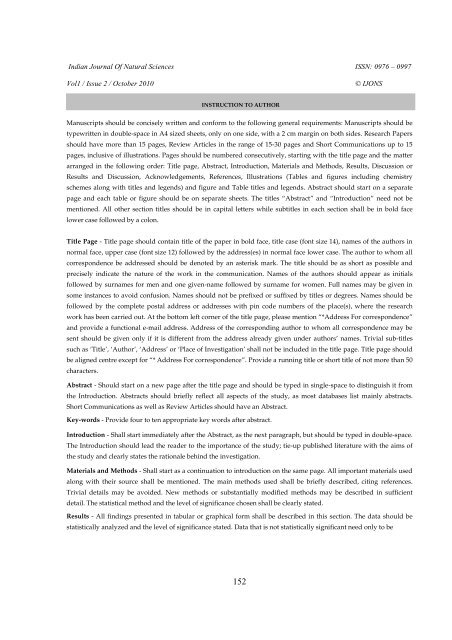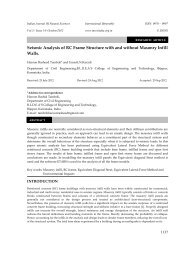Agroecology for Sustainable Food Security - tnsroindia.org.in
Agroecology for Sustainable Food Security - tnsroindia.org.in
Agroecology for Sustainable Food Security - tnsroindia.org.in
You also want an ePaper? Increase the reach of your titles
YUMPU automatically turns print PDFs into web optimized ePapers that Google loves.
Indian Journal Of Natural Sciences ISSN: 0976 – 0997<br />
Vol1 / Issue 2 / October 2010 © IJONS<br />
Manuscripts should be concisely written and con<strong>for</strong>m to the follow<strong>in</strong>g general requirements: Manuscripts should be<br />
typewritten <strong>in</strong> double-space <strong>in</strong> A4 sized sheets, only on one side, with a 2 cm marg<strong>in</strong> on both sides. Research Papers<br />
should have more than 15 pages, Review Articles <strong>in</strong> the range of 15-30 pages and Short Communications up to 15<br />
pages, <strong>in</strong>clusive of illustrations. Pages should be numbered consecutively, start<strong>in</strong>g with the title page and the matter<br />
arranged <strong>in</strong> the follow<strong>in</strong>g order: Title page, Abstract, Introduction, Materials and Methods, Results, Discussion or<br />
Results and Discussion, Acknowledgements, References, Illustrations (Tables and figures <strong>in</strong>clud<strong>in</strong>g chemistry<br />
schemes along with titles and legends) and figure and Table titles and legends. Abstract should start on a separate<br />
page and each table or figure should be on separate sheets. The titles “Abstract” and “Introduction” need not be<br />
mentioned. All other section titles should be <strong>in</strong> capital letters while subtitles <strong>in</strong> each section shall be <strong>in</strong> bold face<br />
lower case followed by a colon.<br />
Title Page - Title page should conta<strong>in</strong> title of the paper <strong>in</strong> bold face, title case (font size 14), names of the authors <strong>in</strong><br />
normal face, upper case (font size 12) followed by the address(es) <strong>in</strong> normal face lower case. The author to whom all<br />
correspondence be addressed should be denoted by an asterisk mark. The title should be as short as possible and<br />
precisely <strong>in</strong>dicate the nature of the work <strong>in</strong> the communication. Names of the authors should appear as <strong>in</strong>itials<br />
followed by surnames <strong>for</strong> men and one given-name followed by surname <strong>for</strong> women. Full names may be given <strong>in</strong><br />
some <strong>in</strong>stances to avoid confusion. Names should not be prefixed or suffixed by titles or degrees. Names should be<br />
followed by the complete postal address or addresses with p<strong>in</strong> code numbers of the place(s), where the research<br />
work has been carried out. At the bottom left corner of the title page, please mention “*Address For correspondence”<br />
and provide a functional e-mail address. Address of the correspond<strong>in</strong>g author to whom all correspondence may be<br />
sent should be given only if it is different from the address already given under authors’ names. Trivial sub-titles<br />
such as ‘Title’, ‘Author’, ‘Address’ or ‘Place of Investigation’ shall not be <strong>in</strong>cluded <strong>in</strong> the title page. Title page should<br />
be aligned centre except <strong>for</strong> “* Address For correspondence”. Provide a runn<strong>in</strong>g title or short title of not more than 50<br />
characters.<br />
INSTRUCTION TO AUTHOR<br />
Abstract - Should start on a new page after the title page and should be typed <strong>in</strong> s<strong>in</strong>gle-space to dist<strong>in</strong>guish it from<br />
the Introduction. Abstracts should briefly reflect all aspects of the study, as most databases list ma<strong>in</strong>ly abstracts.<br />
Short Communications as well as Review Articles should have an Abstract.<br />
Key-words - Provide four to ten appropriate key words after abstract.<br />
Introduction - Shall start immediately after the Abstract, as the next paragraph, but should be typed <strong>in</strong> double-space.<br />
The Introduction should lead the reader to the importance of the study; tie-up published literature with the aims of<br />
the study and clearly states the rationale beh<strong>in</strong>d the <strong>in</strong>vestigation.<br />
Materials and Methods - Shall start as a cont<strong>in</strong>uation to <strong>in</strong>troduction on the same page. All important materials used<br />
along with their source shall be mentioned. The ma<strong>in</strong> methods used shall be briefly described, cit<strong>in</strong>g references.<br />
Trivial details may be avoided. New methods or substantially modified methods may be described <strong>in</strong> sufficient<br />
detail. The statistical method and the level of significance chosen shall be clearly stated.<br />
Results - All f<strong>in</strong>d<strong>in</strong>gs presented <strong>in</strong> tabular or graphical <strong>for</strong>m shall be described <strong>in</strong> this section. The data should be<br />
statistically analyzed and the level of significance stated. Data that is not statistically significant need only to be<br />
152



